DAY TEN: Gorgeous Guayaquil, Ecuador
Afternoon:
Guayaquil is the largest and the most populous city in Ecuador, with around 4 million residents, and is graced with many stunning examples of Spanish, Italian and French influenced architecture.
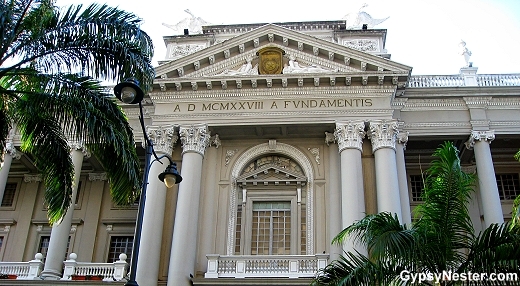 We head out by bus to explore the city with our fantastic guide, Fernando, pointing out the most important, and beautiful buildings. At the central bank, answering a question about the capital of Ecuador, he quips that his home town of Guayaquil is like the New York of Ecuador and Quito the Washington, D.C. “We make the money and they spend it.”
We head out by bus to explore the city with our fantastic guide, Fernando, pointing out the most important, and beautiful buildings. At the central bank, answering a question about the capital of Ecuador, he quips that his home town of Guayaquil is like the New York of Ecuador and Quito the Washington, D.C. “We make the money and they spend it.”
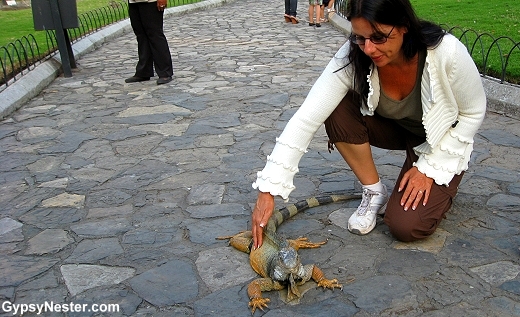
At a downtown park, directly in front of the cathedral, we exit the bus and get a big surprise…

Dozens of Iguanas roaming free, no wonder everyone calls this the Iguana Park. Not quite Galapagos numbers of Iguanas, but a bigger shock to see them right in the middle of a city.

One of the rangers even gives Veronica a chance to feed one… our Spanish es no muy bueno, but we think that sign says don’t feed the animals – maybe we didn’t see the part about unless assisted by a ranger.
To see more about beautiful Guayaquil, click here

From the unlikely lizards we make our way to the Malecon, a two mile long river walk along the Guayas River. We didn’t perambulate the entire distance, but caught the highlights, The Moorish Tower, gardens, statues, snack shops and the like. Hard to think of a nicer spot to while away a sunny afternoon.
Evening:

But Fernando knew an even better spot, Santa Ana Hill in the oldest part of the city.

The stairs leading up the hill are a community all to themselves… and we must say one of the most intriguing quarters of any city we have ever come upon.

The buildings along the stone staircase are all recently refurbished so the little homes, restaurants and shops gleam in brightly colored freshness while kids play and folks mill about chatting and grabbing a bite.

At the top, after 444 steps, there is a small chapel and a lighthouse, plus the reward of a panorama of the entire city.
We check into the Hotel Oro Verde, meaning green gold, which Fernando explains refers to bananas. Ecuador is the world’s leading exporter of bananas and most of them pass through the port here in Guayaquil. The hotel is absolutely extraordinary. Gorgeous rooms and truly first class service.
Dinner at The Hotel Oro Verde lived up to the fine standard set by everything else we encountered here in Guayaquil. Our only complaint is that we couldn’t stay longer.
To see more about beautiful Guayaquil, click here
DAY ELEVEN: The Sacred Valley of the Incas
Morning:
Flying into Cusco, we don’t have to descend very far from our cruising altitude since we will be landing over 11,000 feet high in the Peruvian Andes.
WATCH: The most amazing, insanely beautiful flight we’ve ever taken!

Inside the airport we spot a cure for the light-headed feeling and sleepiness that the low oxygen at high altitude can bring on, a booth with something called OxiShot. But wait, the clerk is out cold, must be the thin air.
Click here to learn how we dealt with altitude issues while in Peru
Afternoon:

On the bus from Cusco to The Sacred Valley of the Incas (Valle Sagrado de los Incas) our guide for this portion of the trip, Eddy, points out the Urubamba River, which formed this valley, is part of the headwaters of the Amazon River.
See more about The Sacred Valley of the Incas

Eddy goes on to explain something that has been misunderstood for centuries. The name for the people who lived in this area when the Spanish came was not the Incas, but the Quechua. Pronounced Ke-chu-wa, the name is routinely used only for the language the people spoke, and many still speak, but that is not really correct. Inca was only the name for the ruler, as in, the Inca ruled over the Quechua. But in order to replace the rulers, the Spanish began to call everyone and everything Inca, thus taking away its royal meaning.

Before we check in to our hotel for the evening, we make a quick stop at the open air market in the town of Pisac.
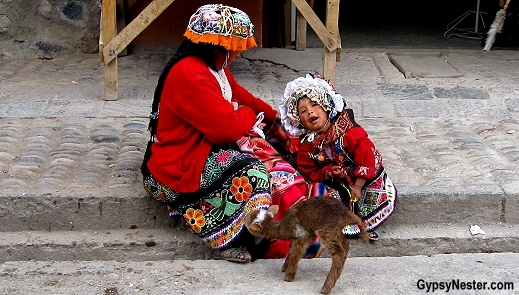
On our way off the bus Eddy warns us that, in the tourist market, many items claimed to be made of the finest “baby alpaca” wool are more likely made from the notorious “maybe alpaca” wool.


Our hotel for the next two days is the Posada del Inca in Yucay, a beautiful former convent. The grounds are stunning, with wonderfully restored buildings surrounded by gardens that would make the greenest green thumb green with envy.

Upon arrival we are offered coca tea, a local tea purported to help with altitude issues. A bit timid about trying it, we decide to give it a shot since we had both nodded out on the bus. We don’t want to miss anything! We’ll be sure to report on its effects, if any.
Click here for more ways we dealt with the altitude
Evening:

Dinner at Posada del Inca gives us a chance to try some alpaca. Our first real culinary adventure on the trip, alpaca is basically a smaller version of the llama. Although they look somewhat like sheep, alpaca are actually a relative of the camel. Can’t say we ever had a hankering to try any roasted dromedary, but the alpaca looked quite good. Tastes like chicken, just kidding, more like veal but with a texture a bit like liver.
DAY TWELVE: Secrets of The Sacred Valley
Morning:

We begin a new day in the highlands of Peru by taking a bus over a mountain pass to the town of Chincheros.

In town our guide Eddy tells us how the mountain people hold on to their traditions and directs our attention to the roofs of the houses. Small shrines including a cross indicating the family is Christian, ceramic bulls for strength and fertility, a cask of corn beer to tie them to their ancestors, and a vial of holy water to sanctify the house.
See more about The Sacred Valley of the Incas

Another age-old tradition is weaving and we are given a demonstration of the Quechua techniques, from spinning the yarn…
…and dying it with colors obtained from various plants, minerals…

See more about our visit to this wonderful weaving cooperative!

Then the yarn is woven into cloth with intricate patterns and figures. The final result is amazing and has been accomplished in this manner for centuries.
WATCH: How Peruvian rugs are made – you’ll never believe some of the “secret” ingredients that are used in the dying process!
See more about our visit to this wonderful weaving cooperative!
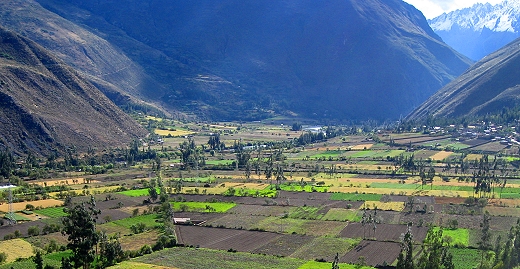
Next we learn about the agriculture of the area, from agronomist Maywa Blanco, who explained much of which we got to see on our bus ride over here.

For the Quechua, survival requires wide diversity in their crops to help insure an acceptable harvest in the unpredictable mountain climate.
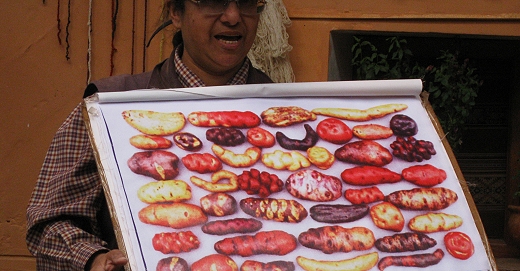
To account for various weather possibilities, such as unusually dry, wet or cold conditions the planting would be scattered over several months and at many different altitudes. Also many varieties of the same type of crop would be planted, for example over two hundred types of potatoes have been known to be raised in this area.

To finish up with our agriculture culture, we sneak in some street food and grab a choclo con queso -yum! The cheese is unbelievably buttery.
Afternoon: 
The afternoon gives us our first chance to see some ruins from back in the time when the Incas ruled the Quechua.

The Ollantaytambo Ruins are not ruins in the traditional sense, they are in too good of shape. This is more like a town that still contains some original buildings constructed in the time of the Incas, overshadowed by huge stone terracing that leads up to an unfinished temple. It is where the Inca came to make their last stand in the highlands against the Spanish.

Many of the stones were left sitting where ever they happened to be at the time that work was abandoned so Eddy points out some of the amazing stone cutting and shaping. Our guide, Eddy, points out many of the unfinished stones that show how this site was still under construction when the Spanish arrived in the 1500s.

The terracing goes all the way up the mountain and was designed not only to provide flat spaces for farming, but also to prevent landslides and flooding in times of heavy rains.
Even in the thin air up here, we make our way to the top and get a view on one side across the valley of the quarry where the stones were originally cut…

…and on the other we can see stone buildings that were used for storing grain.

We did, however, find another way to help with the altitude – coca candy. We’re convinced it and the tea are helping. We’ve even taken to chewing the leaves!
Click here for more ways we dealt with the altitude

From there the giant rocks were hauled down the mountain, over the river, and back up this mountain, all without the use of wheels. One of the many mysteries that surround the building abilities of the Quechua people when ruled by the Inca is the lack of the wheel. Eddy offers us the theory that the round shape represented the sun and moon and therefore was sacred so it could not be used for such mundane tasks as moving rocks, but no one knows for certain why they didn’t use wheels.

Another of the mysteries of Ollantaytambo is exactly how the stone was cut, because no metal hard enough to cut granite was available at that time. Since the Quechua language was not written, and the Spanish destroyed most evidence of methods used in construction, we may never know the answers.

Evening:
In the evening anthropologist Teo Paredes gives us a briefing on our visit to Machu Picchu, and more of the mysteries and mysticism of the ancient people of this remarkable region. Tomorrow we will see these first hand, and hopefully begin to understand more.
DAY THIRTEEN: Heading to Machu Picchu (or our day of eating pets)
Morning:

The big day has arrived, today we see Machu Picchu, but first a train ride. And not just any old train, a narrow gauge ride along the Urubamba River through spectacular Andes mountain scenery. The Expedition Train takes us down The Sacred Valley to the town of Aguas Calientes, base camp for our two days at the site of one of the New Seven Wonders of the World.

Upon arrival we waste no time and proceed directly to the road up to Machu Picchu. We do not stop to eat, we do not check into our hotel, we do not pass go, we do not collect two hundred dollars, we just jump on a bus for a harrowing ride up a crazy-sheer cliff.
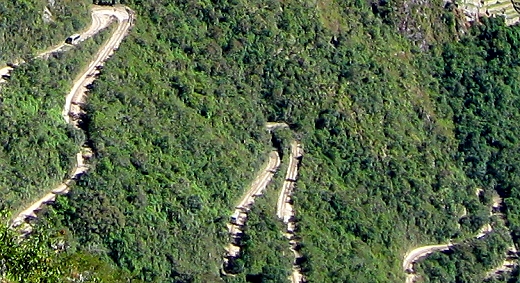
The road takes thirteen switchbacks to make it up the mountain, all while passing busses coming back down this much-less-than-two-lane dirt road. Several times we are hanging right on the edge… with no guard rails… not that they would stop a bus from going over the side. But hey, they would make us feel better.

As soon as we round the last switchback and see the site spread out before us, all of that is forgotten.

Super-guide Eddy is going to take us through the entire site, but first lunch and some delicious Goldfish Cerviche… we have no idea, hopefully a translation snafu and not actually the bowl-inhabiting pet. Crazy name aside, it’s tasty.
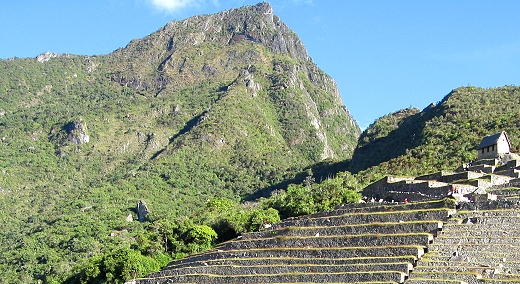
Over our Goldfish, Eddy explains that Machu Picchu is not really the name for the city – the original name is lost forever. When Hiram Bingham came here in 1911 the locals told him of a place between Machu Picchu (old mountain)…

…and Huayna Picchu (young mountain). When he told the world of his “discovery” (How does one discover something that lots of people already knew about?) the name stuck.
more pics from our Machu Picchu journey – & more info about this incredible site!
Afternoon:

Once inside, Eddy begins our tour by showing us the very different styles of stone work, which implies that the building of Machu Picchu took place at different times. This goes against many of the guidebooks we have seen that claim the entire city was built, occupied, and abandoned within the span of about one hundred years. Eddy most certainly doesn’t buy that theory, but as with so much about the time of the Incas, the facts remain a mystery.

By cutting and arranging the stones in what appears a random fashion at first glance, using no mortar between the stones and slightly slanting the walls inward, the structures have survived numerous quakes that have destroyed almost all of the newer buildings in their path.

Many things about the Quechua can be ascertained with some certainty through their reverence for the sun, moon, earth and water and their skill as builders and designers. Throughout the Inca Empire the buildings were made to withstand earthquakes.
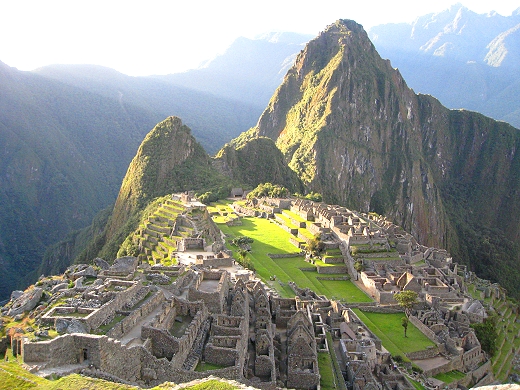
Another point that Eddy makes is that it is not the ruins themselves that are so mind blowing, it is the location.
At first that sounds strange, but as we look throughout the sight we have to agree. Not to discount the remarkable structures and work involved, just to acknowledge that this spot is truly amazing above and beyond the ruins.

Theories abound as to the purpose of this place… summer home for the Inca, agricultural testing site, hideout, fortress, or sacred city, but no single explanation seems to fit. Perhaps the truth is some combination of these that will forever remain a mystery.
more pics from our Machu Picchu journey – & more info about this incredible site!

As the tour continues Eddy shows us a rock cut and placed to represent and align with The Southern Cross, then another incredibly carved boulder that aligns with the sun called Intihuatana. In the Quechua language inti means sun and watana (huatana in Spanish) means place to tie up. So this is often called the hitching post for the sun.

A small building contains two carved stone pools that perfectly reflect the sky to the viewer at an angle through a window when standing on the small rocks that mark the proper spot. It is believed that these were used for star gazing at night… perhaps an Inca version of late night TV.

In one tiny entrance we notice a strange doorway. A wall blocks direct access, forming a kind of S turn to get inside, so we asked Eddy about it. He says this is a storage room and the extra wall was to keep the llamas out of the food supply. Ingenious.

See more great photos of the pensive llamas of Machu Picchu!

Speaking of llamas, our fellow Road Scholar, Bill, saves the day by applying his llama whispering skills to this stubborn, furry fellow blocking our path.
When the site closes at five, we head back down the crazy road to find our hotel and some food.
more pics from our Machu Picchu journey – & more info about this incredible site!
Evening:

After we check into the very European feeling Hotel El Mapi, we toast the day with a Pisco Sour. Pisco is a distilled grape type of brandy and is considered the drink of Peru.
Since we have sampled the quintessential Peruvian drink, and we have tonight to explore culinary adventures on our own, we figured we should set out in search of some cuy for dinner. Cuy is Guinea Pig – yes just like the pets – and is traditionally eaten in the highlands on special occasions. We decide an occasion couldn’t get much more special than celebrating our visit to Machu Picchu so when we see a place with cuy al horno (oven roasted guinea pig) on the menu, we sit right down.
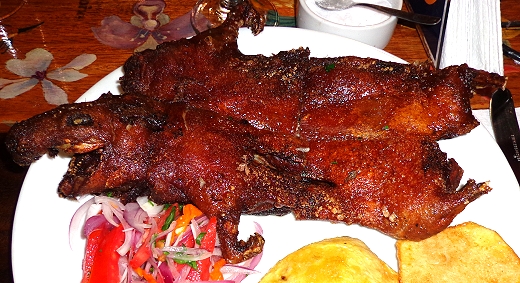
The cuy comes baked and quartered on a plate, head and all, with some potatoes on the side. Most disturbing are the tiny little feet and the two buck teeth.

But we’ve come this far so we have to eat it. Once again with the old cliché… it tastes like chicken. Only this time it’s true. Like a chicken thigh, or closer to rabbit. It’s good, and yes, we ate the whole thing… which is not really very much.

As we lay our heads down in our beautiful room at the Hotel El Mapi in Aguas Calientes, we dream of the sunrise at Machu Picchu tomorrow -AND we look back on one of the best days of our lives.
Click here to learn how we dealt with altitude issues while in Peru
DAY FOURTEEN: Breaking the Day at Machu Picchu
Early Morning:
For our second day at Machu Picchu we decide to get up before daylight so we can watch the sun rise at the Temple of the Sun while most of the other Road Scholars sleep in and then take in the sights of Aguas Calientes.
Several sources mentioned long lines for the bus to go up, but once again Eddy steers us in the right direction and advises us to get to the bus just before 6am. At 5:55 we walk right on to the second bus.
Morning:

With daylight breaking we scurry toward the temple which stands in the center of the ruins. Luckily the sun does not break over the mountains until over an hour after actual sunrise.
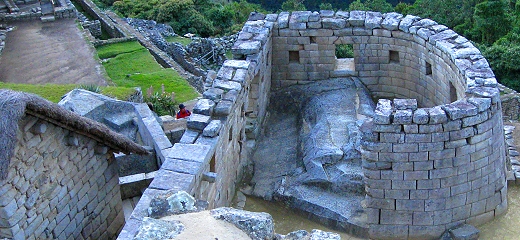
We stake out a spot above where we can watch the sun come through the window of the temple. Two windows are aligned so that on the solstice the sun will rise in a notch on the mountain and shine directly through them. Since we are less than a week away from the June solstice (winter here, summer in the northern hemisphere), we figure it should be pretty darn close.
Sunrise! It is pretty darn close and the window lights up as advertised. Everyone around us is feeling very in tune with the cosmos right about now.




more pics from our Machu Picchu journey – & more info about this incredible site!

From the temple we climb upward to the top of the ridge between Machu and Huayna Picchu and get our first view of the back side of the ruins. We are surprised by how much is back here. We would say it is about half as big as the front side, but concentrated more on the terraces that were used for farming and, perhaps more important in this case, preventing erosion and landslides.
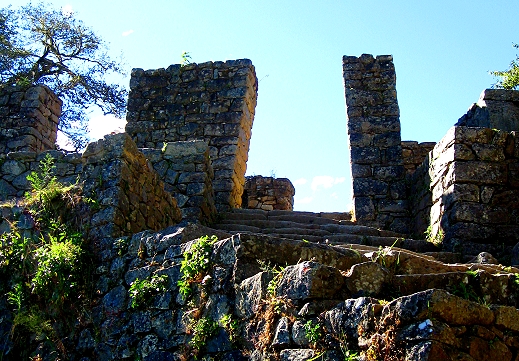
From here the famous Inca Trail leads up to the Sun Gate, or Inti Punku in the Quechua language.
The Inca Trail is a remnant from the expansive system of roads or trails that spanned Tawantinsuyu, the Quechua name for the Inca Empire.
The trail takes about an hour to hike up another few hundred feet above sea level from the main part of Machu Picchu, taking us over 2,000 feet above the valley below. Inti Punku is the spot where the sunrise can be seen from the Sun Temple window on the solstice in December. It is also where hikers that have walked the four days along the Inca Trail from The Sacred Valley get their first view of Machu Picchu.

For almost an hour we simply soak it all in until we need to make our way back so we don’t miss our train. Missing the train would be a problem since it is the only way in or out of Aguas Calientes… unless we want to walk back up to the Inca trail and hoof it another four days back to Ollanaytambo.
more pics from our Machu Picchu journey – & more info about this incredible site!
Afternoon:
WATCH: The breathtaking scenery through the Sacred Valley to Machu Picchu on The Expedition Train! This is the second highest railroad in the world, after the Qinghai–Tibet Railway.
In addition to the spectacular scenery as we head back up The Sacred Valley, the train’s crew entertains us with a traditional dance, including wild costumes, and a fashion show of alpaca wool items. These are not “maybe alpaca” and the prices reflect it, so we are content to just watch.
Evening:
We finish our day in Cusco, formerly the capital of The Inca Empire, and try our best to digest all we have seen in the last two days.
DAY FIFTEEN: Day of the “Sexy Woman”
Evening:

Our day in Cusco begins with a trip to the Sacsayhuaman ruins. Sacsayhuaman, pronounced very close to “sexy woman” (which proves easy to implant in our memory banks), is remarkable for the size of the stones. Pictured is the lovely Diana, Road Scholar and sexy woman, putting the size of the stones in perspective.

Some of the blocks weigh in at around 200 tons and, as with every other site we have visited, they are expertly carved and placed.

Eddy gives us an excellent explanation as to how the builders used the force of gravity to set the stones into each other and strengthen the structure. Each piece is cut to fit exactly in place and distribute the weight so as to hold everything in place. Some of the gigantic stones have a grid laid out over them to lend a better understanding to the wonkiness.
See more about the Sacsayhuaman site
Most of the site was destroyed by the Spanish after their conquest and the stones removed to be used in constructing new buildings down below in the city of Cusco, so only the largest rocks remain.

We scramble up to the top and find a fantastic view of Cusco, dubbed the Navel of the World during its run as the center of the Inca Empire. Sadly, only the foundations of the once splendid temples that used to stand at Sacsayhuaman are left.
See more about the Sacsayhuaman site

Many of the buildings in Cusco are built on top of the seemingly indestructible Quechua stone work walls.
Click here to see more pics and info about Cusco!
Afternoon:
 Leaving the sexy woman behind, we make our way to the Korikancha, Temple of the Sun. This was the most important temple in the empire, dedicated to Inti, the sun god.
Leaving the sexy woman behind, we make our way to the Korikancha, Temple of the Sun. This was the most important temple in the empire, dedicated to Inti, the sun god.
Because of the incredible stone stacking abilities of the Quechua, the original walls of the temple withstood earthquakes that reduced the Convent of Santo Domingo that Spanish colonists built on top of them to rubble.

The convent was rebuilt, damaged again, and repaired to its current state as a museum.

Inside our guide, Eddy, promises to blow our minds, and proceeds to show us a perfectly circular hole drilled through solid stone. The method to accomplish this is completely unknown to modern man. OK, minds blown!
Click here see more about The Temple of the Sun!

We also find a classic double doorway that indicates a special sacred room.

In this, and several other rooms, we see more of the window-like niches that are very common in all of the ruins we have visited. The construction of these niches is almost identical to windows except that they do not go completely through the wall, so no light comes through. They served as places for offerings, such as the best of the harvest or corn beer, to please the gods.

From one temple to another, we head to the center of the belly button, Plaza de Armas and the Cathedral of Santo Domingo.

The plaza is unique in that it is dominated by two churches, because of a falling out between the Jesuits and Dominicans centuries ago. Both were built directly on top of the palaces of former Inca rulers with stones taken from Sacsayhuaman. (There’s that sexy woman again.)
We really have just one goal in mind, find the painting of The Last Supper where Jesus and the disciples are eating cuy. That’s right, we hear there’s a guinea pig last supper in the Cathedral of Santo Domingo.

Inside the cathedral we find alters layered with insane amounts of silver, literally tons, but we are on a mission… and we succeed. A version of the classic scene, by Marcos Zapata, featuring a platter of cuy and bottles of chicha, the traditional corn beer.
Click here to see more pics and info about Cusco, her churches and this Last Supper!
Evening:
With our artistic mission accomplished we’re ready for a demonstration of traditional Peruvian musical instruments with Gustavo León Flores at our hotel, the lovely Casa Andina.

Gustavo begins with the wind instruments by showing us many varieties of the ceramic Ocarina and flute-like quena made from bone or bamboo.

Next he demonstrates the sicus or zampolla, a version of panpipe that has practically become synonymous with Andean music. Other more exotic horns include the wakrapuku, made from cattle horns, and the conch shell.

Gustavo plays all of the instruments expertly, especially the final group of stringed, where begins with a tune on a very different looking harp.

Gustavo even gives David a shot on the charango, or kirkincho when it’s made from an armadillo shell, but our intrepid GypsyNester is somewhat flummoxed by the twenty strings… fourteen more than he’s used to.
Click here to learn how we dealt with altitude issues while in Peru
DAY SIXTEEN: Amazing Food in Lovely Lima, Peru
Morning:
Our last day of our Road Scholar trip begins with a surprise. It’s the feast of Corpus Christi and a huge procession in honor of St. Jerome is staging right in front of our hotel. Each year on Corpus Christi the churches of Cusco carry their patron saints through the streets to the cathedral in the main square.

The processions include bands, dancers…and very feisty llama…

…and then culminates with a huge likeness of the saint carried through the streets on the shoulders of a couple dozen men.
WATCH: The surprise procession in front of our hotel!
With the parade passed, we can proceed to the airport and our flight to Lima.
Afternoon:

In Lima we get a quick tour of the main square, Plaza Mayor, and a brief history lesson. From the square we go to Señorio de Sulco Restaurant for a class in Peruvian cuisine.
To see more about our antics in Lima, click here

We begin with Ceviche Pescado, it is commonly held that ceviche originated in Peru and it is somewhat of the national dish. Our chef, Ricardo, marinates filet of sole in lime juice, onion, chili peppers, salt & pepper, cilantro and leche de trigre, or tiger’s milk, which is made from fish sauce and more citrus juice. This is served with boiled sweet potatoes (camote) and toasted corn known as cancha.

The next dish is Causa Limeña, delicious mashed potatoes prepared with lime, onion, chili and a little oil, layered with avocado and chicken salad, formed in a round mold and beautifully garnished.
Do you love cooking classes like we do? Click here to see our classes from around the world!

For the main event, Chef Ricardo breaks out a wok and fires up some Lomo Saltado. This is a marinated, sliced beef stir fried very fast at high temperature with onions, garlic, tomato and soy sauces, then served with rice and french fries. Simple and crazy delicious.
WATCH: Chef Ricardo makes Causa Limeña – Oh. Yum.
Lucky for us, after watching these dishes get prepared we get to have our last meal together as Road Scholars by devouring Ricardo’s efforts.
To see more about our antics in Lima, click here
| PREVIOUS DISPATCH: Galapagos Islands |
David & Veronica, GypsyNester.com
We’re traveling with Road Scholar – a not-for-profit organization – through Ecuador, Peru, The Galapagos Islands, Machu Picchu and much, much more!




Hi my name is ANTONY VARGAS I’M a Tour guide
in Machu Picchu and CUSCO and i would say this
is a exellent blog about things in my town
if is posible for new visitor i recommend also
go to San pedro MARKET , it is just few block from
main plaza de armas , there are lots of things you
can learn and buy for a good price and people are very nice.
also make sure to book in advance hostels,train tickets and machu picchu fee , huayna picchu need to
book in advance , apoximatly 3 months before you visit machu picchu.
if you want to contact someone to help you make a good plan in
cusco my small company http://www.inkaltitude.com we will be happy to help.
Thanks for the information Antony.
Sounds like you had some amazing experiences in the navel of the world! With a visit to Cusco and Machu Picchu on the horizon, I really enjoyed all this great info and am super jazzed! Very interesting to hear Eddy’s perspectives, especially on how the Incas came to be known as such – it makes total sense!
We did! Most certainly a highlight of our lives. Eddy was great, got to spend several days with him and his insights were fantastic, plus he was not afraid to say “I don’t know.” That was good because there is a lot still unknown about The Quechua people.
Your Blog is amazing. I liked the humor. You write so well, not overwheming the reader with too much info, but certainly enough to keep me going for more. Great job.Bob, will send you his DVD’s this week. When is your next adventure? We enjoyed meeting you,you are a unique couple.
“The Hinton’s’
Hey you sexy woman – great to see you here! Really looking forward to the DVDs – I can’t relive that adventure enough. We’ve got some cool stuff coming up, some California coast action and maybe Europe again this fall. Life is good. 🙂 What about you guys? -Veronica
You guys are really seeing, doing and eating it all! Those buckteeth might have turned me off from finishing my plate though! Gorgeous shot of Machu Picchu.
I so look forward to the food of Peru!
I want to thank you for taking the time to post so many wonderful stories, tips, facts and pictures. I am sure you are sorry to see it end as we are to see the blog finish. Now that you are home and have time to reflect please tell us what you are glad was included and what we should not miss when we go in Oct. and any specific tips from your experience. Any good restauants on your free days and any specific sights or places to go that were not part of the tour. Any items of clothing that we need to bring or not? Thank you again. Now that the laundry is done and your stuff is unpacked — Where to next time?
Now that we have finished the “live” portion of our trip, we are going to go back and revisit each place with more in depth stories. These should answer most of your questions about specifics. Check back over the next few weeks and we will do our best to fill you in on all of the details.
Welcome home! Thanks for the reply. I am looking forward to your posts.
This trip is in my plans for May or June of next year. After reading your blog and seeing the wonderful pictures, it will be very difficult to wait that long! Thanks for all the info. Did your guides comment on what are the very best times of the year to take this particular trip?
Because it is so close to the equator the temperature is about the same year round, but one thing to keep in mind is the rainy season. It runs from around October to May. We missed it (by luck, not planning) and the weather was perfect, so next June should be good.
Glad you found the coca, including the candy, helpful. We thought it was very effective. So many happy memories in your pictures and reflections…we were there just a little over a year ago and love seeing your posts.
I will be duplicating this trip in July — and your blog is really getting me excited for it! Thanks for sharing!
Have a great time… we sure did.
Absolutely love reading your blog. I love learning about places I’ve never been. Sounds like you have a great guide, I’m sure this makes all the difference as to how you really see a place and it’s culture.
The guides were all fantastic with a real love for the history and culture of their areas. This is their home and it really shows. We especially enjoyed meeting Franklin in the Galapagos and Eddy in Peru.
It’s so great following your daily adventures. Thanks for being so great by doing this. How’s the temperature in Peru? Are you guys wearing long/short sleeves, pants/shorts,jackets,layers? We will be there in late Oct-early Nov which should be the same kind of weather. How are you spending any free time you have? Finding any great restaurants or sights we need to see?
Enjoy the rest of your adventure.
The weather has been nearly perfect the entire trip. Not quite shorts temps in Peru (unlike Ecuador) but sunny and warm, cool at night. We have had some free time and tried several local foods including the cuy (otherwise known as guinea pig).
We visited Machu Picchu before there were digital cameras. It was excruciating to have to wait until we got home to see how our photos turned out. And film was expensive when we were newlyweds, so we had to ration our shots which as you know is very hard to do at Machu Picchu where there’s something photo worthy everywhere you look. Our splurge was staying at the hotel up at the ruins. Actually, in 1982, there weren’t too many other options. Aguas Calientes was little more than the railroad station. The place was magical when almost all the tourists left on the train back to Cuzco and only the hotel people were left.
Are you going to climb Huayna Picchu? We did it in our 20’s when we still had that patina of youthful (misguided) immortality. It was scary. No technical climbing, but lots of very narrow trail with steep drop offs.
We have sung the praises of digital cameras many times on this trip. Didn’t climb Huayna Picchu but did make it up to the sun gate. A good bit less harrowing and well worth the hike.
So glad you are having fun. Looks amazing.
It most certainly has been.
Wow, it looks like you guys are having an awesome time! Brings back so many memories of our time in Peru. We loved the ruins at Ollantaytambo. Glad you got to visit them.
I’m curious to see your photos of the most beautiful flight you’ve ever been on. I flew into Cuzco with my husband on our honeymoon in 1982 and he still has the scars on his arm to prove it. I guess it was beautiful, but I didn’t like looking out at the sides of mountains. My recollection is that the plane had to fly more or less through the mountains to approach Cuzco and then it’s up and over the lip of the “navel of the world.” A Peruvian friend explained to us that if they get to Cuzco and there clouds, they head back to Lima because they have to be able to visually see the runway to land. Maybe it has changed now, but we flew to Cuzco on a commercial jet liner, so maybe not.
Your recollection is pretty right on. We flew between two mountains, then turned around and came in through the valley at a steep drop. Video is coming soon – we’re so busy trying to see everything, we can’t keep up with all the video! 😉
Everything! I want to see everything! LOL! This is mesmerizing! I love it all! 🙂
“Dromedary”…I am learning all sorts of new words reading your blog, in addition to cultural facts! Loving it!
Educational & entertaining! That’s what we shoot for. 😉